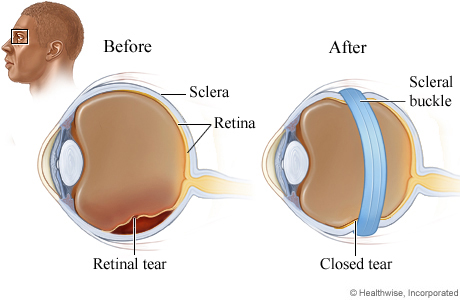Surgery Overview
Scleral buckling surgery is a common way to treat retinal detachment. It is a method of closing breaks and flattening the retina.
A scleral buckle is a piece of silicone sponge, rubber, or semi-hard plastic that your eye doctor (ophthalmologist) places on the outside of the eye (the sclera, or the white of the eye). The material is sewn to the eye to keep it in place. The buckling element is usually left in place permanently.
The element pushes in, or "buckles," the sclera toward the middle of the eye. This buckling effect on the sclera relieves the pull (traction) on the retina, allowing the retinal tear to settle against the wall of the eye. The buckle effect may cover only the area behind the detachment, or it may encircle the eyeball like a ring.
By itself, the buckle does not prevent a retinal break from opening again. Usually extreme cold (cryopexy) or, less commonly, heat (diathermy) or light (laser photocoagulation) is used to scar the retina and hold it in place until a seal forms between the retina and the layer beneath it. The seal holds the layers of the eye together and keeps fluid from getting between them.
Other facts about the surgery
- The surgery takes place in an operating room, usually on an outpatient basis (you go home the same day).
- Local or general anesthesia may be used.
- Before the surgery, your eye doctor may patch both of your eyes and have you stay in bed to keep the detachment from spreading. Right before surgery, the doctor will use eyedrops to dilate your pupils and may trim your eyelashes to keep them out of the way.
- A first-time surgery usually lasts 1 to 2 hours. Repeat surgeries or more complex detachments may take longer.
How It Is Done

A scleral buckle is a piece of silicone sponge, rubber, or semi-hard plastic. In scleral buckling surgery, the buckle is placed against the outer surface of the eye and sewn onto the eye to keep it in place. The buckle pushes the sclera toward the middle of the eye, relieving the pull on the retina and allowing the tear to settle against the wall of the eye.
Extreme cold (cryopexy) or light (laser photocoagulation) is used to scar the area around the tear. The scarring helps keep this area from moving so that a seal can form between the retina and the layer beneath it. In most cases, the buckle will stay on the eye forever.
What To Expect
You may have some pain in your eye and your vision may be blurry for a few days after the surgery. Your eye may be swollen, red, or tender for several weeks. Your eye doctor may put drops in your eye that prevent infection and keep the pupil from opening wide (dilating) or closing (constricting). You may have to wear a patch over the eye for a day or more.
Why It Is Done
Scleral buckling is effective in supporting a tear, hole, or break in the retina that has caused the detachment. It is rarely helpful on its own when scar tissue tugging on the retina has caused the detachment (traction detachment).
How Well It Works
Placing a scleral buckle reattaches the retina in most cases.footnote 1
Chances for good vision after surgery are higher if the macula was still attached before surgery. If the detachment affected the macula, good vision after surgery is still possible but less likely.
Risks
Scleral buckling poses some short-term and long-term risks. Most of these complications do not happen very often. Risks include the following:
- The most common cause of failure in surgery for retinal detachment is a type of scarring on the retina, called proliferative vitreoretinopathy (PVR), that can cause the retina to detach again. PVR usually requires additional treatment, including vitrectomy surgery.
- Detachment of the choroid (a part of the tissue that forms the eyeball) or swelling in the retinal area may delay healing.
- The pressure of the scleral buckle can raise the fluid pressure inside the eyeball. People with glaucoma may have a higher risk of this complication.
- Bleeding in the eye can impair vision.
- The eye may become infected. You may need antibiotics and corticosteroids to reduce redness or discharge from the eye and treat the infection. Sometimes it is necessary to remove the buckling implant to treat the infection.
- The plastic or rubber of the buckling device may rub on other parts of the eye, move out of place, or become a site of infection. In some cases, the buckling device may need to be removed.
The surgery may also affect your vision in other ways:
- Since a scleral buckle pushes in on the eye, it can change the shape of the eye. Good vision depends on the shape of the eye. The change caused by a scleral buckle may cause a refractive error that can affect vision. Vision may change for several months after scleral buckling surgery. You should have a follow-up vision exam after about 6 months to check for vision changes. You may need glasses or contact lenses (or a new prescription) to correct the changes.
- The scleral buckle can affect the eye muscles and how well they control the movement of the eyes. This can lead to misaligned eyes (strabismus) and double vision (diplopia).
References
Citations
- Sena DF, et al. (2021). Pneumatic retinopexy versus scleral buckle for repairing simple rhegmatogenous retinal detachments. Cochrane Database of Systematic Reviews, 11: CD008350. DOI: 10.1002/14651858.CD008350.pub3. Accessed June 28, 2022.
Credits
Current as of: July 31, 2024